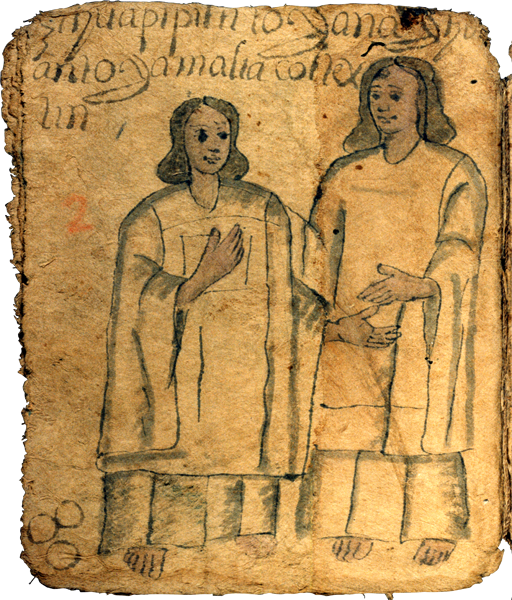Bk. V, f. 1v., two indigenous noblewomen (colonial attire)
This page, which is the back side of the seventh folio of sixteen folios (also Book V, folio 1 verso), shows representations of possible historical personages of early Spanish-colonial Santa María Iztacapan (modern State of Hidalgo, Mexico).
In this scene, two indigenous women stand, dressed in what appears to be white cotton clothing, with long tunics over floor-length skirts. They are outlined in black. Some shading appears on their arms and shoulders, and marking the draping of the cloth. The tunic of the woman on the left has a rectangle below the v-neck, suggesting it is the blouse of an indigenous woman. The women’s toes appear below their skirts; the feet appear to be bare. The women’s hair reaches their shoulders, and appears curled under at the bottom. The hairstyles do not include the bumps at the top of the head that was a hallmark of sedentary pre-Columbian hairstyles for Nahua women.
Text runs along the top of the page, identifying the women as nobles and giving their names (as dona Ana and dona María Cortés). [SW]
página entera de un folio (pintura y texto)
Esta página, es la cora frontal del séptimo de dieciséis folios, muestra las representaciones de posibles personajes históricos del período colonial temprano en Santa María Iztacapan (en el estado moderno de Hidalgo, México).
En esta escena, dos mujeres indígenas se encuentran de pie, vestidas con lo que parece ser algodón blanco, con túnicas largas sobre faldas largas. Están delineadas en negro. Algunas sombras aparecen en sus brazos y hombros, y marcando las arrugas de la ropa. La túnica de la mujer en la izquierda tiene un rectángulo debajo de un cuello en forma de V, sugiriendo que es la blusa de una mujer indígena. Los dedos del pie aparecen por debajo de la falda y sus se encuentra descalza. Su pelo llega a la altura de los hombros, rizado en la parte inferior. Los peinados no incluyen el jopo en el centro de la cabeza, caracteristica de las mujeres Nahuas en el período precolombino.
En la parte superior de la página se encuentra un texto que identifica a las mujeres como nobles y las nombra (doña Ana y doña María Cortés)
